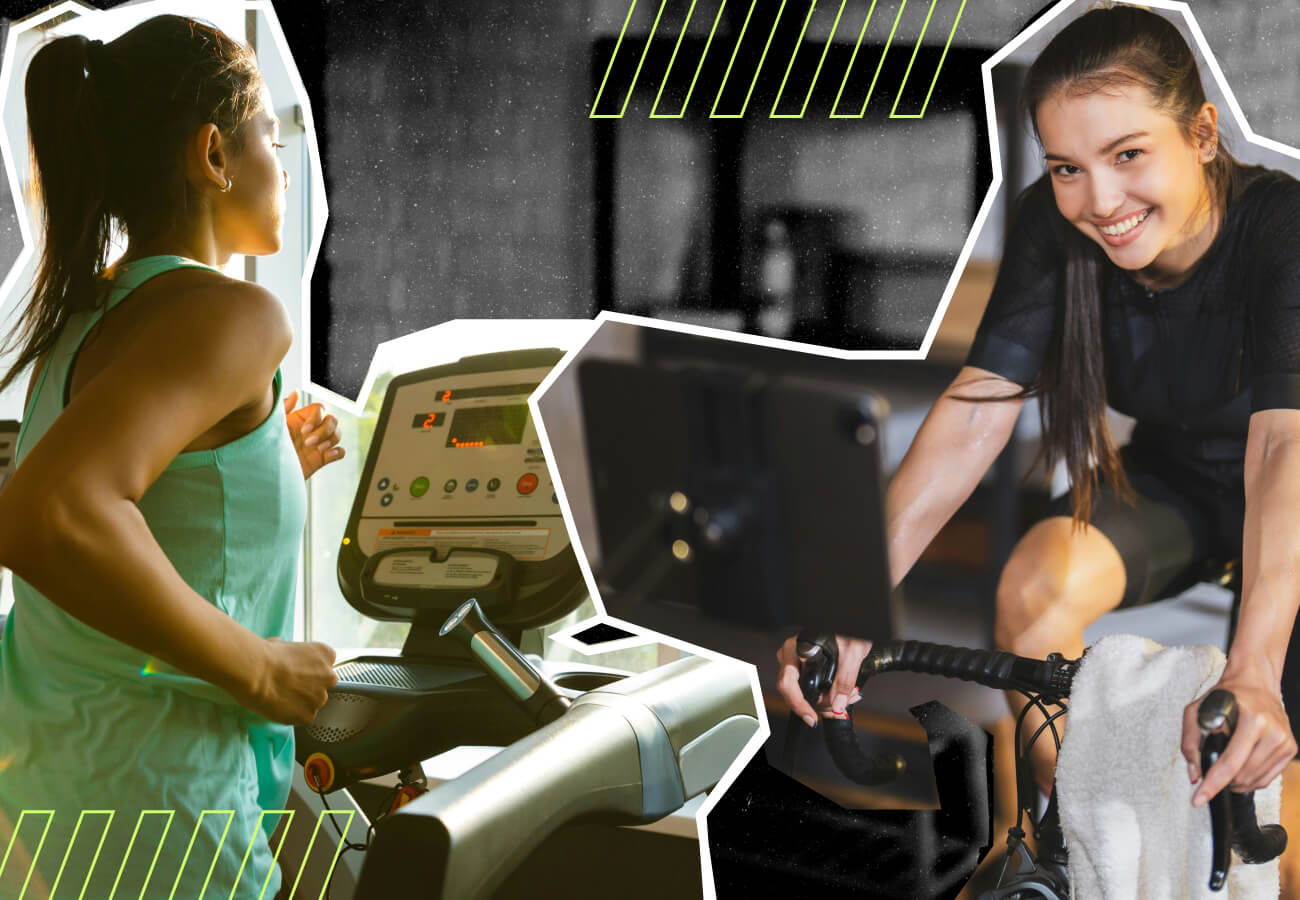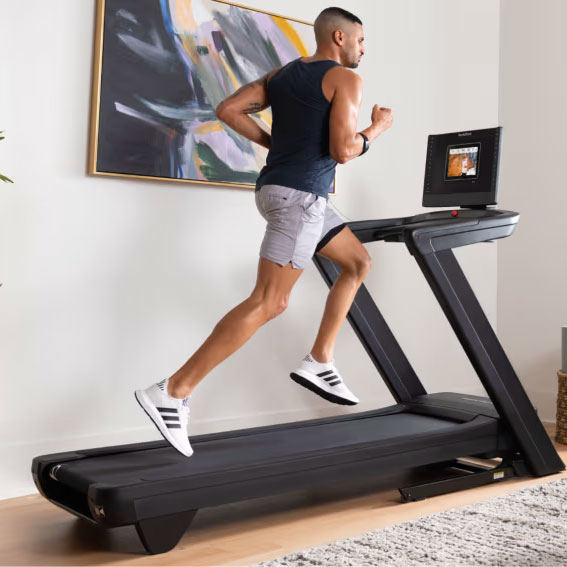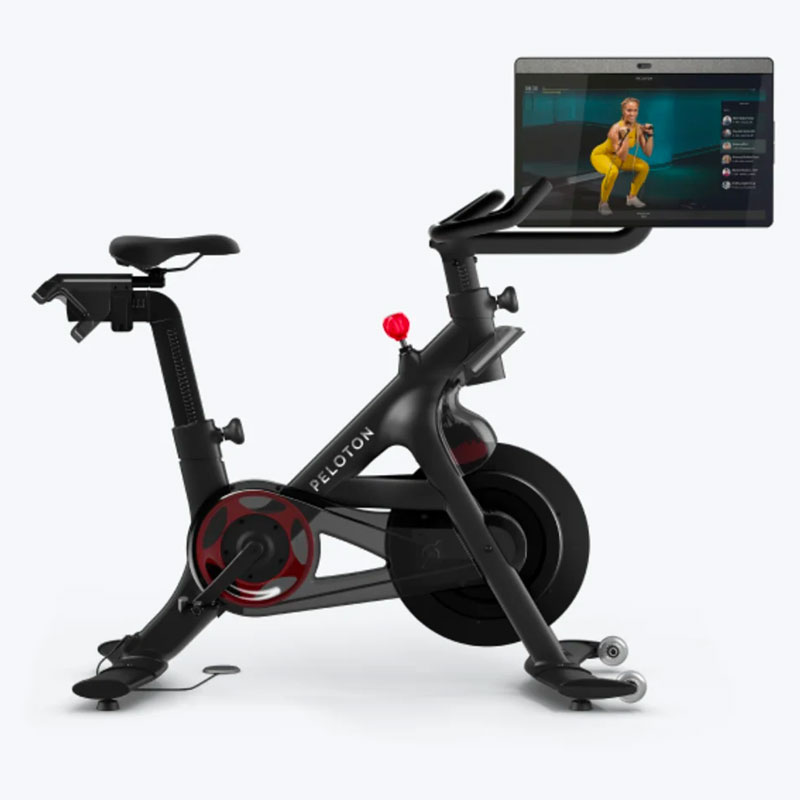Stationary bike vs. treadmill: Which is the best workout?

Whether you are outfitting a home gym or choosing which piece of exercise equipment to hop on at the gym, treadmills and stationary bikes are indisputably the most popular options.
Cardio workouts are vital in a fitness routine to improve your overall health, performance, and well-being. While you can reap these benefits with both the treadmill and exercise bike, understanding their unique features will help you make a more informed choice.
Here, we’ll explore the pros and cons of these cardio equipment options. When it comes down to treadmill vs. bike, selecting the one right for you is all in the details.
The basics: Treadmills vs exercise bikes
Exercise bikes can be as simple as hooking up your road bike to a meter for the winter to advanced technology with livestreaming classes. Exercise bikes simulate outdoor cycling through resistance – adding resistance is like pedaling up a hill. You can challenge the intensity of a ride between your cadence (how fast you pedal) and power output (resistance).
Exercise bikes are, for the most part, entirely inclusive. Recumbent bikes provide back support for those who need it, and more competitive cycle bikes challenge more advanced riders who can stand in different positions on the bike.
Treadmills range from foldable walking pads for your work-from-home setup to connected treads with shock-reducing belts. You control the intensity through speed (ranging from walking to all-out sprints) or incline (flat road to hiking).
If you can walk without discomfort, treadmill exercise may be a viable option. Running on the treadmill is also one of the best ways to improve aerobic capacity at your personal training threshold.
Both treadmills and stationary bikes target similar muscle groups, including quads, hamstrings, glutes, hip flexors, and core. Higher speeds on the treadmill and different positions on the handlebars on a stationary bike will target your upper body muscles.
Treadmills
If you’ve ever thought a treadmill workout felt like torture, that was its original purpose. In the 19th century, prisoners typically spent 8 hours on “treadwheels” to power mills.
Treadmills reappeared more humanely to test aerobic capacity for stress tests by Dr. Robert Bruce in the 1940s (leading to the Bruce protocol used by most cardiologists today). Treadmills were introduced in the 1960s by Dr. Kenneth Cooper, an Army and Air Force physician, for general exercise and use in space.
Pros of Treadmills
Here are some key benefits of using a treadmill to consider:
- Variability of workouts: You have more freedom of movement and programming on a treadmill. This versatility challenges different muscle attributes like your ability to bounce off quicker from the belt in sprints, working your stretch-shortening cycle that directly improves agility in life and sport.
- Intensity: The machine moves you (as opposed to a self-determined pace on a bike), making it easier to push yourself with pace. The added challenge of keeping up a pace may also be why treadmill use burns slightly more calories than exercise sessions on a bike.
- More muscle recruitment: Treadmill workouts activate more muscles to propel you forward with each step. In addition to lower body muscles, you’ll recruit more upper and core muscles with faster speeds, and with inclines, you’ll activate more posterior chain muscles.
- Aerobic capacity: If you’re metrics-driven, a 2022 study suggests you’ll likely achieve a higher VO2max performance on a treadmill than on an exercise bike.
- Bone density: As we age, our bone mineral density is compromised, increasing the risk of osteoporosis and bone fractures. Weight-bearing exercises like walking and running on a treadmill spurs new bone growth, improving bone density.
- Technology: Like exercise bikes, connected treadmills connect you with live or on-demand instructors, other live users, scenic virtual reality locations, and full connectivity with your wearables. Low-cost treadmills and walking pads will include simple screens with speed and incline.
Cons of Treadmills
There are potential drawbacks to adding a treadmill to your home gym or gym routine. Be sure to assess these factors before deciding:
- Higher risk of injury: Treadmills require balance and proprioception to keep your feet safely on the belt. However, most models have safety keys to wear if you take a spill. Treadmills also provide high-impact exercise, which is excellent for bone density but may cause joint discomfort for some individuals.
- Space limitations: Treadmills have a large footprint and may require a specific ceiling height (especially if you’re on the tall side), so your designated workout space may limit your ability to install a treadmill.
- Cost: Treadmills have more advanced motor and electrical needs than bikes, often driving up the unit price. Additionally, repairs on a treadmill may require more costly parts than a bike.
- Practicality: You can perform many of the same functions of a treadmill outdoors at no cost. It may be necessary in bad winters, but if you regularly walk, hike, or run outside, consider whether investing in an alternative cardio machine may be more practical.

Exercise Bikes
While the bicycle has existed for centuries, indoor cycling is still relatively new. The Schwinn company started manufacturing upright exercise bikes in 1967 and the popular Airdyne stationary bike in 1978. In the mid-1980s, Johnny Goldberg (Johnny G) developed the SPINNING© bike. Since then, indoor cycling has been a mainstay in cardiovascular exercise training.
Pros of Exercise Bikes
Here are some reasons why you might consider an exercise bike as your piece of equipment of choice:
- Space-saving: An exercise bike’s small footprint allows it to fit in even the most limited space (just ask New Yorkers who squeezed their bike into 400-square-foot apartments).
- Price: Exercise bikes typically boast a lower price tag than treadmills, which require large motors.
- Low-impact: Bike workouts will have less wear and tear on your joints as you aren’t weight-bearing during the workout – making it a great cross-training option. The bike still counterbalances your weight even if you’re out of the saddle.
- Training control: If you have specific heart rate training thresholds you’re aiming for (like Zone 2 endurance or ventilatory threshold), it’s easier to exert control over intensity on a bike by adjusting resistance or cadence. You can also slow down or speed up without changing settings.
- Intensity variability: Your cycling workout is as hard as you make it. You can dial in to push yourself in high-intensity interval training (HIIT), threshold training (zone 4 heart rate training), endurance Zone 2 training, or anything in between. If you’re feeling sore from a strength workout, it’s a great option to shake out your legs, with some brands offering scenic bike rides.
- Technology: You can join virtual cycling workouts virtually anywhere in the world and sync heart rate monitors and wearables to your bike for real-time data feedback. Even low-cost bike options on the market have some sort of meter that tells you power, distance, and cadence metrics.
Cons of Exercise Bikes
You may want to think twice if a stationary bike is the suitable exercise machine for you at the gym or your home gym based on these pitfalls:
- Calorie burn: Depending on your intensity on the bike, research indicates that running on a treadmill may tip the scales on overall calorie burn during a workout.
- Static position: While you ride in and out of the saddle, you’re still glued to the pedals, adjusting only resistance and speed. Plus, getting steps in during your exercise session may be more advantageous if you have a primarily sedentary job.
- Aerobic capacity: While cyclists will reach a higher VO2max on a stationary bike, most people will achieve higher VO2 levels on a treadmill since running recruits more overall muscle tissue.
- Bone density: Low-impact exercise is excellent for crosstraining and when joint pain has you down for the count. But direct impact on your bones (like walking or running) is necessary to boost bone mineral density.

Calorie burn and weight loss
Your calorie burn during a workout depends on various factors, like your body weight and the intensity of the exercise machine. For example, riding a hill at high resistance and cadence will burn more calories than a stroll on the treadmill.
A study published in the Journal of Strength and Conditioning Research indicates that indoor cycling burns around 7.98-10.48 calories per minute while running on a treadmill burns 8.18–10.78 calories per minute.
In running, one study found runners saw more significant weight loss than walkers over six years. However, another meta-analysis found walking routines created modest weight loss results. In indoor cycling, one study saw a 3-percent reduction in body mass and a 5-percent reduction in body fat mass following a long-term cycling intervention without a caloric deficit.
Cardiovascular exercise, whether on a treadmill or bike, contributes to overall energy expenditure. A holistic program with cardio and strength training can facilitate lasting weight loss combined with a caloric deficit. Moreover, regular exercise reduces the risk of cardiovascular and metabolic diseases and improves overall well-being.
Reducing body fat may be more critical for health – visceral fat (better known as belly fat) is associated with a range of adverse health conditions. The physical and mental health benefits of regular cardio aid the reduction of systemic inflammation (or chronic inflammation), which can result in a smaller waistline.
A weight loss program looks different for everyone, and there’s no right answer to the best way to get you there. The most important factor is choosing cardio activities you will enjoy and consistently participate in and that will challenge you over time.
It depends on your goals
Choosing a treadmill or an exercise bike hinges on your personal preferences and fitness goals. Tailoring your choice to your needs and fitness level results in a better workout experience that you’re more apt to stick to in the long run.
- Treadmills offer diverse workouts and may burn more calories but come with higher injury risks and costs.
- Exercise bikes are space-saving and cost-effective, providing low-impact workouts with precise intensity control.
Both cardio equipment options contribute to overall health, fitness, and wellness and you always dictate the workout intensity. When you choose, remember that finding enjoyment and consistency in cardio activities is paramount to achieving and maintaining your fitness.

 Published on Feb 27, 2024 by
Published on Feb 27, 2024 by 








